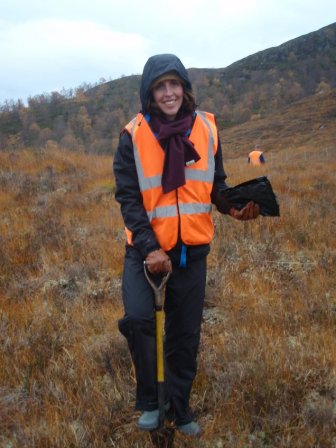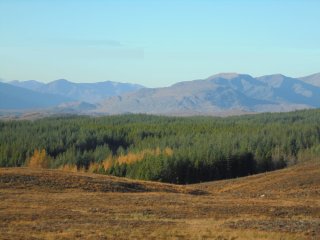Category: Blog
Mia Lutsch spent a week up in the Scottish Highlands on a Conservation Week with Trees for Life in October last year. She recounts her experiences of spending time in nature and becoming a Conservation Week Leader leader during the week.
 The main focus of the charity is replanting the Caledonian forest, which has been destroyed by human activities through the course of centuries. Some of the destruction was due to material needed for warfare, while farming, commercial hunting and the disappearance of large predators also played a role. On this week I was in training to lead conservation volunteers, and I had to assist with planting demonstrations and other conservation activities. Talking to the land and the trees is habitual for me, but my practical conservation knowledge is limited. So when I led the planting demonstration, I mostly did it by the book.
The main focus of the charity is replanting the Caledonian forest, which has been destroyed by human activities through the course of centuries. Some of the destruction was due to material needed for warfare, while farming, commercial hunting and the disappearance of large predators also played a role. On this week I was in training to lead conservation volunteers, and I had to assist with planting demonstrations and other conservation activities. Talking to the land and the trees is habitual for me, but my practical conservation knowledge is limited. So when I led the planting demonstration, I mostly did it by the book.
During the activity, a volunteer asked whether it is necessary to remove grass from the surrounding turf to eliminate competition and give the newly planted tree the best chance to survive. I passed the question on to another facilitator, and he said that because machine mounding had been done, the terrain was prepared. The practice of removing the top layer of vegetation around the tree might have been required if this weren’t the case. In the meantime, however, I have learned that results are poorer when this is done.
If only we could learn how to work with nature, how to be nature, then maybe we could leave a legacy for generations after us without destroying what should be available to them.
We were working in the heart of a plantation at Dundreggan Estate, owned by Trees for Life. Looking around at the imposing non-native trees planted in rows with almost militant precision, our task of recreating a near-natural forest was daunting to say the least. Those small native trees have to be given the best chance to survive, and planting is hard work and time-consuming. I find it almost heart-breaking to think of the beauty and tranquillity of natural forests that could be destroyed so easily through aggression, greed and short-sightedness. The effort to rebuild is painstaking, and the irony is that if we left Nature to her own devices she would create a majestic work of art, without being paid for it and seemingly with no effort, just because life. If only we could learn how to work with nature, how to be nature, then maybe we could leave a legacy for generations after us without destroying what should be available to them.
 That idea, competition. In terms of conservation ecology when one is trying to give nature a helping hand, it makes sense. Those tiny trees have been cultivated by human hands with a lot of care before they are given a proper home. Working with them in the Tree Nursery, I got a sense of excitement, as if they couldn’t wait to push their roots deep down into the earth and reach up, little by little every year, to drink in light from the sun and touch the stars. They have to be protected, otherwise all the sweat and love that have been poured into them go to waste. A good idea rots if not properly applied, but if it doesn’t work after having been given the right kind of effort, the energy moves on to be used elsewhere.
That idea, competition. In terms of conservation ecology when one is trying to give nature a helping hand, it makes sense. Those tiny trees have been cultivated by human hands with a lot of care before they are given a proper home. Working with them in the Tree Nursery, I got a sense of excitement, as if they couldn’t wait to push their roots deep down into the earth and reach up, little by little every year, to drink in light from the sun and touch the stars. They have to be protected, otherwise all the sweat and love that have been poured into them go to waste. A good idea rots if not properly applied, but if it doesn’t work after having been given the right kind of effort, the energy moves on to be used elsewhere.
Nonetheless, I have to reflect on how our ingrained ideas springing from millennia of conditioning influence our understanding of nature. Looking at nature, I see a circle of life, and in her presence I feel connection and flow. There is a clash in my soul between this calm presence and society’s idea that we need to fight for some things and compete for others. Seeds grow when there is a proper place for them to do so, and a healthy ecosystem is established when different species work together as one organism. When the life force is behind it, the right time for everything to grow and decay establishes itself. This is the sacred energy that many people feel in natural forests. Somehow I can’t help wondering if our beliefs that some people deserve life more than others, and some ideas are worth defending more than others, cause the imbalance that ruins the harmonious working together of organisms. I wonder, if we stop aligning with ideologies that exclude others from our family, whether the idea of competition would also fade away. Maybe then we could approach our homes and relationship with those outside of our homes as an ecosystem, where there are no defined boundaries, but wellness on a small scale can be expanded indefinitely no matter what the size of the population is.
It is clearly preposterous to think that one part of a forest has to compete with another part of a forest. A forest would be boring if one species had to reign supreme or if other species were extinguished. There is space for everyone, and where only one thing can grow in any particular place, the species that would be able to adapt best would be the survivor. I could imagine that other plants would willingly step aside and say, “Clearly this is a better place for you, so I would find another place to thrive. I’ll sit on the hilltop and talk to you while you stand in the shade.”
I’m hoping that those of us who have the privilege of spending time in nature will take her wisdom back to the concrete jungle with us. I have faith that the more we bring our forgotten human nature to our disconnected lifestyles, the more we would see healthy forests in our living spaces, and the less land would be used for purposes of exploitation and conflict. I wonder if the idea of eliminating competition to ensure the success of our own enterprises, even in conservation projects, would eventually be replaced by one of consciously working together to restore harmony on earth.
This blog has been reproduced from Mia's website and can be found here.
- All
- Blog
- Dundreggan
- Education
- Forest
- General
- News
- Off the beaten track
- Press Release
- Projects
- Volunteer Voice
- Wildlife
